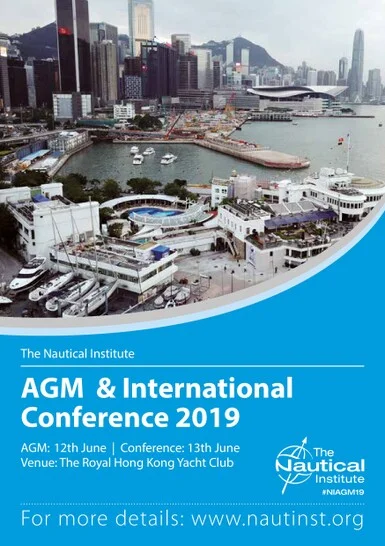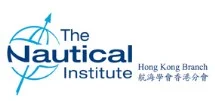conf2019
archive > archive documents > conference 2019

Summary - Shiphandling Conference 2019
The conference was held at the Royal Hong Kong Yacht Club – a new venue featuring stunning views of the harbour – and was over-subscribed with more than 130 people signing up for the event, including delegates from the United Kingdom, Singapore, Sri Lanka, India, Australia, USA, South Korea and China. The hard-working local organising committee were ably supported by John Lloyd and his headquarters team, notably Magdalena Kolodziej who worked tirelessly to ensure the success of the event.
The conference was opened by branch Chairman Amit Bhargava, who welcomed the delegates and thanked the sponsors before introducing NI President Capt. Nick Nash. Capt. Nash gave an overview of the work of The Nautical Institute, updated us on major issues and shared his ideas about the future.
Hong Kong’s Director of Marine, Ms. Agnes Wong Tin-yu, then described our place in the shipping world, and the many advantages enjoyed by the maritime cluster in the territory. We are grateful to her for agreeing to speak to us so soon after she was appointed to the post, and we look forward to working with her in the future.
Our first session was on the consequences of shiphandling failures. Capt. John Taylor from Steamship Mutual described the cost of failure, with some telling examples of the consequences when bridge teams fail to properly use the tools they have at their disposal. He used interesting case studies to illustrate his points. In the first, a container ship ended its passage plan at the pilot station and did not do an adequate exchange of information with the pilot. The pilot himself had not undergone any refresher training since he was appointed, and had a poor appreciation of the vessel’s manoeuvring characteristics, whilst the bridge team took no action when they disagreed with the pilot’s decisions. The port penalised pilots who were slow in berthing, so the approach was too fast and resulted in significant damage to the berth and the container cranes lining the wharf.
In another example, a ship had a good passage plan, which was disrupted when the port moved the pilot boarding station. The master was unfamiliar with the ECDIS on the ship, and some alarms were turned off. The result was spectacular, and Capt. Taylor asked if we are becoming too reliant on ECDIS?
Capt. Ashley Singleton of Chevron discussed the special considerations when handling large tankers, concentrating on specific ports and offshore berths used by his company’s ships. He stressed the need for adequate tugs and dedicated teams who know what they are doing at every stage of the process.
Ron Clark, Admiralty Manager at Reed Smith in Hong Kong then covered the legal consequences of shiphandling incidents and described the Admiralty courts and the apportionment of blame in collision cases. He described a collision off a South American port and stressed the importance of keeping clear of vessels which are picking up a pilot. Whilst individual cases turn on their own facts and are judged on their merits, the importance of Colregs Rule 2 can never be underestimated.
Our next session concentrated on shiphandling in heavy weather. Capt. Balraj Nair, a serving master with Fleet Management, urged delegates to know their ship and its rolling and pitching characteristics, to identify refuge areas and always select a suitable speed and heading. He gave excellent examples of how to do these things, and included preparations for heavy weather, lashings, and how to manage stability and ballast when necessary. Interestingly, he stated that obtaining accurate weather information is vital, and basic weather forecasting is insufficient in the modern world. He also stressed that modern seafarers are losing their knowledge of the sea and its moods because they spend too much time in the air conditioning. He gave clear descriptions of synchronous and parametric rolling and how to disrupt them, talked about surfing down large swells and the danger of broaching, and described how to turn a ship in heavy weather.
Tony Petronio of StormGeo then talked about weather routing and how predictions at least three days ahead are vital to avoid heavy weather. He discussed the need for routers to consider a ship’s priorities and understand its roll period and other characteristics. After a review of world weather patterns and the changes which are taking place, he gave a case study involving Typhoon Maria and the forecasts from the Japan Meteorology Agency and the Joint Typhoon Warning Centre. He demonstrated that sometimes there are alternative routes which must be considered, and it is not always clear which is the best.
The session concluded with Ashok Kumar Sharma of Wartsila discussing ways that digital technologies can support command decisions in shiphandling. As a former seafarer, he was ideally placed to cover this topic in a practical way. Starting with the building blocks of ECDIS, radar and communications equipment, then adding shoreside tracking and voyage planning, he showed how they can facilitate safe and efficient shiphandling. He advocated new technology which permits automatic voyage planning combined with weather routing, and claimed this can save time and prevent weather-related incidents, so long as you have a good connection.
After an excellent lunch, delegates were treated to a short presentation by Benjamin Wong of InvestHK, who explained the importance the government place on the maritime cluster, described the advantages of Hong Kong as a place to do business, and briefly outlined the opportunities available within the Greater Bay Area.
We then turned our attention to shiphandling training, with Nick Nash again taking to the podium, but this time in his role as a senior master with Carnival Corporation. He described bridge manning and the division of responsibility on a modern passenger ship, and discussed how shipping can learn from aviation and adopt function-based procedures, which are superior to the top-down model traditionally employed at sea. He explained how such procedures are better at detecting and managing errors, and described the P.A.C.E approach to bridge operations. He told us how Carnival are using these methods ‘to turn port approaches and berthing into a science’, and publishing the results so others can learn about ports they might not have visited.
Capt. Kersi Deboo, Director of the Anglo-Eastern Maritime Training Centre, then spoke about the benefits of simulator training. Few mariners will have an opportunity to practice their shiphandling at sea, but a simulator permits immersion in realistic scenarios where the common causes of shiphandling failures can be addressed. In particular, he cited simulators as being excellent for teaching people spatial awareness and an understanding of the effects of weather and currents.
Stephen Gosling of Videotel then gave an interesting presentation on modern audio-visual training techniques, and described the change from traditional training videos to more interactive methods which appeal to the younger generation of seafarers and can be useful for self-assessment. He also set up a virtual reality booth in one corner of the conference room so delegates could immerse themselves in modern technology.
John Lloyd, our CEO, described the Nautical Institute’s DP accreditation scheme. This has been a tremendous success, as readers will know, and John gave an excellent description of how it has benefited several generations of shiphandlers in the offshore industry.
The final session of the conference was devoted to a panel of pilots – possibly the ultimate experts on shiphandling. Capt. Jason Choi, Vice President of the International Maritime Pilots Association, described the difficulty of handling modern ships which he described as having poor course-keeping ability and insufficient power if they have been optimised for economic steaming. His home port of Incheon has a tidal range of 10 metres and limited room to manoeuvre – a problem he said is widespread because ships are getting much bigger but ports remain the same size!
We then heard from Capt. Wong Xiao-tian, a senior pilot in Tangshan who is an expert at berthing Valemax bulk carriers on an exposed jetty with currents up to 2 knots. He described the problems of dealing with large fishing fleets in the area and coordinating up to seven tugs and over 100 people who are involved in every berthing job.
Capt. Cai Bin is a senior pilot in Shanghai, and discussed the berthing of large passenger ships – up to three every day – in a river with strong currents. He took issue with the manning arrangement utilised by Nick Nash, saying the pilot should be seated at the front of the team so he can see what is happening. He claimed some passenger ship captains lack shiphandling skills, and suggested some of them spend too long in the simulator and not enough time on the controls of a ship. It was an interesting paper, and his difference of opinion with Capt. Nash would make a fascinating topic for another day, but time did not permit us to go into more detail in Hong Kong.
Capt. Luo Jin-song is a senior pilot in Shenzhen, and he described the difficulties of moving 20,000 TEU container vessels through the Tonggu Channel to his port. Again, he mentioned the poor turning and stopping abilities of large modern container vessels, although he confided that some are better than others. Windage, of course, is a problem on all of them, and when you include a current running across the channel and the presence of a large fishing fleet, the problems are multiplied.
Finally, Capt. Stephen Wong of the Hong Kong Pilots Association gave an excellent description of the changing pilotage techniques which have been adopted in Hong Kong to deal with modern vessels, particularly the world’s largest container and passenger ships.
At this point it seemed we had defined the problems of shiphandling in the modern era and the tools available to assist with training, and if we had been granted a few more hours we could have reached some useful conclusions about a sensible way forward. At the end of the session, a SLIDO poll of the delegates asked them to rank the main causes of shiphandling incidents, and the majority cited lack of effective shiphandling training as the most prevalent cause.
Unfortunately, we were only ten minutes away from our deadline, so it was left for John Lloyd to give a masterful summing-up of the conference before we adjourned for the cocktail party.
A.L.

